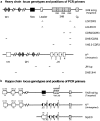Somatic mutation and light chain rearrangement generate autoimmunity in anti-single-stranded DNA transgenic MRL/lpr mice
- PMID: 10477553
- PMCID: PMC2195620
- DOI: 10.1084/jem.190.5.691
Somatic mutation and light chain rearrangement generate autoimmunity in anti-single-stranded DNA transgenic MRL/lpr mice
Abstract
Antibodies to single-stranded (ss)DNA are expressed in patients with systemic lupus erythematosus and in lupus-prone mouse models such as the MRL/Mp-lpr/lpr (MRL/lpr) strain. In nonautoimmune mice, B cells bearing immunoglobulin site-directed transgenes (sd-tgs) that code for anti-ssDNA are functionally silenced. In MRL/lpr autoimmune mice, the same sd-tgs are expressed in peripheral B cells and these autoantibodies gain the ability to bind other autoantigens such as double-stranded DNA and cell nuclei. These new specificities arise by somatic mutation of the anti-ssDNA sd-tgs and by secondary light chain rearrangement. Thus, B cells that in normal mice are anergic can be activated in MRL/lpr mice, which can lead to the generation of pathologic autoantibodies. In this paper, we provide the first direct evidence for peripheral rearrangement in vivo.
Figures







References
-
- Tan E.M. Antinuclear antibodiesdiagnostic markers and clues to the basis of systemic autoimmunity Pediatr. Infect. Dis. J. 7Suppl1988. S3 S9 - PubMed
-
- Hardin J.A. The lupus autoantigens and the pathogenesis of systemic lupus erythematosus. Arthritis Rheum. 1986;29:457–460. - PubMed
-
- Shlomchik M.J., Marshak-Rothstein A., Wolfowicz C.B., Rothstein T.L., Weigert M.G. The role of clonal selection and somatic mutation in autoimmunity. Nature. 1987;328:805–811. - PubMed
-
- Craft J.E., Hardin J.A. Linked sets of antinuclear antibodieswhat do they mean? J. Rheumatol. 14Suppl1987. 106 109 - PubMed
Publication types
MeSH terms
Substances
Associated data
- Actions
- Actions
- Actions
- Actions
- Actions
- Actions
- Actions
- Actions
- Actions
- Actions
- Actions
- Actions
- Actions
Grants and funding
LinkOut - more resources
Full Text Sources
Other Literature Sources
Molecular Biology Databases

